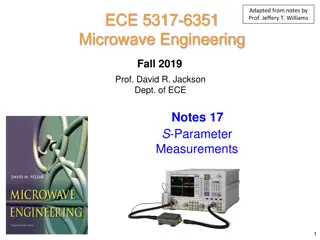Understanding Heating Process in Microwave Oven
Model simulation showcasing the heating process in a microwave oven through electromagnetic analysis and transient heat transfer. Explore how heat redistributes in a potato placed inside the oven at 2.45 GHz frequency. Analyze the absorbed power, microwave distribution, and temperature evolution over time in the potato. Gain insights into the resonant cavity behavior and power reflection, revealing the intricate dynamics of microwave heating.
Download Presentation

Please find below an Image/Link to download the presentation.
The content on the website is provided AS IS for your information and personal use only. It may not be sold, licensed, or shared on other websites without obtaining consent from the author. Download presentation by click this link. If you encounter any issues during the download, it is possible that the publisher has removed the file from their server.
E N D
Presentation Transcript
Microwave Oven COMSOL
Introduction This is a model of the heating process in a microwave oven The distributed heat source is computed in a stationary, frequency-domain electromagnetic analysis followed by a transient heat transfer simulation showing how the heat redistributes in the food
Model Definition The microwave oven is a metallic box connected to a 2.45 GHz microwave source via a rectangular waveguide operating in the TE10 mode Near the bottom of the oven there is a cylindrical glass plate with a spherical potato placed on top of it The microwave operates at 1 kW, but when we use symmetry to reduce the model size by one half, we only input 500 W in simulation Geometry 1
Model Definition The symmetry cut is applied vertically through the oven, waveguide, potato, and plate The figure shows both the full and reduced size geometry Geometry 1
Model Definition Electromagnetic Waves, Frequency Domain
Model Definition Heat Transfer in Solids
Results The figure shows the distributed microwave heat source as a slice plot through the center of the potato The rather complicated oscillating pattern, which has a strong peak in the center, shows that the potato acts as a resonant cavity for the microwave field The power absorbed in the potato is evaluated and amounts to about 60% of the input microwave power Most of the remaining power is reflected back through the port Dissipated microwave power distribution (W/m3). Full size (top) and half size (bottom)
Results The figure shows the temperature in the center of the potato as a function of time for the first 5 seconds Temperature in the center of the potato during the first 5 seconds of heating. Full size (top) and half size (bottom)
Results Due to the low thermal conductivity of the potato, the heat distributes rather slowly, and the temperature profile after 5 seconds has a strong peak in the center (see the figure) When heating the potato further, the temperature in the center eventually reaches 100 C and the water contents start boiling, drying out the center and transporting heat as steam to outer layers Deformed electric field and Temperature distribution after 5 seconds of heating. Full size (top) and half size (bottom)
Results This also affects the electromagnetic properties of the potato The simple microwave absorption and heat conduction model used here does not capture these nonlinear effects However, the model can serve as a starting point for a more advanced analysis Deformed electric field and Temperature distribution after 5 seconds of heating. Full size (top) and half size (bottom)























